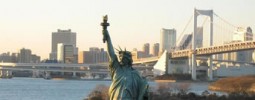Monterrey is the third largest city in Mexico. It is the capital of the state of Nuevo Leon in the northeast of the country. The city is located at the foothills of Sierra Madre Oriental mountains. After the Mexican Independence War Monterrey became an important business center. The city also experienced industrial growth over the years. It has a population of around 1.3 million people.
Most tourists come to Monterrey for business purposes. The city is full of life and vibrant, far Americanized. It enjoys high standards of living and has emerged into a progressive, modern city. It is however more than just a commercial and industrial center. Tourists can enjoy a wealth of cultural and entertainment attractions. There are restaurants, hotels, shopping malls and bars where travelers can taste some of the city’s famous beers. The Gran Plaza has modern buildings, gardens and monuments.
Enjoy the cutting edge contemporary architecture of buildings as the Puente Atirantado, the Puente Viaducto de la Unidad or the new circular TEC business school. If you like arts, visit the The Museo de Artes Contemporaneos (MARCO) with many temporary exhibitions. History is shown in the Mexican History Museum where you can look at the times the Maya, the Aztec, the Olmecs, the Toltecs and other civilizations ruled the lands. Monterrey has parks to every taste, such as the urban oasis Park Fundidora and the rugged mountain oasis the Chipinque Mesa.
Travelers to Monterrey need a valid passport and visa. American and Canadian citizens can also use a birth certificate with photo ID. Any traveler to Cancun needs a Mexican government issued tourist card (Mexican Tourist Permit), which is free of charge upon arrival. Don’t forget the beautiful surroundings of Monterrey. Take some days to visit the wildlife safari park, the Prese de la Boca dam or climb the saddle-shaped mountain Cello de la Silla. There are excellent opportunities for outdoor adventures.
Cancun is a coastal city in Mexico on the Yutacan Peninsula. It is a popular vacation spot with around 4 million tourists every year, mostly from America. The city is located on the Yutacan Channel and is split into two main areas, the Zona Hotelera and the Ciudad Cancun. The first area is a “7″ shaped island with modern beachfront hotels, much like the American city Las Vegas. Ciudad Cancun is situated on the mainland where tourists can find more budget accommodation.
Cancun attracts visitors with its beaches, ocean and dolphins. Snorkeling and scuba diving are common activities. The ocean is for more advanced swimmers, while any resort facing the island of Isla Mujeres is suited for less experienced swimmers and children. Cancun has a thriving nightlife, much unlike other party cities or scenes. The city has numerous hotels and resorts for tourists that like lying on the beach. Tourists that come here shouldn’t mind sharing the beaches with many others.
From Cancun tourists can easily visit the Riviera Maya, which has numerous archeological sites of the Maya people. Here you can visit Coba and Tulum for instance. The area also has many denotes to swim in and ecological parks. Other day trips include visiting Chichen Itza and its historical ruins and Isla Mujeres for snorkeling and enjoying eating in waterfront restaurants.
Travelers to Cancun need a valid passport and visa. American and Canadian citizens can also use a birth certificate with photo ID. Any traveler to Cancun needs a Mexican government issued tourist card (Mexican Tourist Permit), which is free of charge upon arrival. You will need this permit to leave the country. Be aware that timeshare and condos are big business in Cancun. “Free tours” don’t exist, they are for sales talk purposes only. Only use ATM machines inside banks or hotels or else there’s a possibility to become a victim of identity theft.
Mexico City is the capital of Mexico with a population of 8.7 million people. The city is the world’s third largest urban area and fills a highland basin 2240m above sea level, so you might feel a bit light-headed upon arrival. Its the most important center of economic, industrial and cultural in Mexico.
In the recent years Mexico City is experiencing a well deserved increase in interests. Travelers often dismissed Mexico’s capital because of the city’s problems including crime, pollution, and overcrowded areas. Now that these trends have decreased, the culturally curious have been rediscovering what originally led so many to this magnificent city. The city is filled with cultural treasures and energy, although some compare it to great European cities the regular Mexico City traveler disagrees.
Mexico offers many historic attractions, from ancient ruins Olmecs, Maya and Aztec, to train routes used by the brash. When it comes to the capital, many travelers believe the city itself is a museum counting over 2000 historical buildings, all situated around the Zocalo such as: the Rufino Tamayo, the National Art Museum, the Anthropology Museum and Diego Rivera museums.
Travelers to Mexico City must have a Mexican government issued tourist card, which is easy to obtain. Some nationalities may require to obtain a visa. Because regulations changes regularly, it’s advised to confirm them with a Mexican embassy or consulate before your trip.








